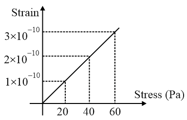EASY
Earn 100
Write two applications of elastic behaviour of the material.
Important Questions on Properties of Solid and Liquid
MEDIUM
The elastic behaviour of material for linear stress and linear strain, is shown in the figure. The energy density for a linear strain of is _____ . Assume that material is elastic upto the linear strain of .

EASY
MEDIUM
MEDIUM
MEDIUM
MEDIUM
MEDIUM
(Young's modulus of steel )
MEDIUM
MEDIUM
EASY
[Young's modulus of wire ]
HARD
EASY
MEDIUM
= Young's modulus of the material of rod, coefficient of linear expansion
EASY
MEDIUM
MEDIUM
EASY
HARD
MEDIUM
MEDIUM

